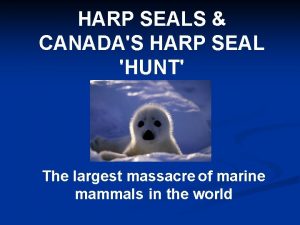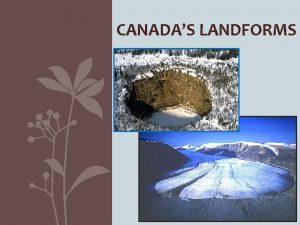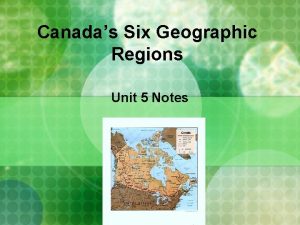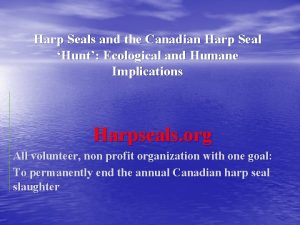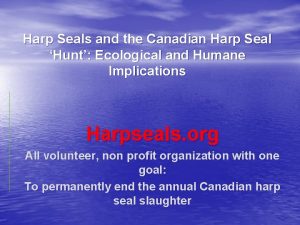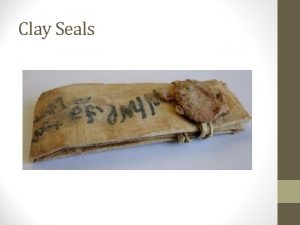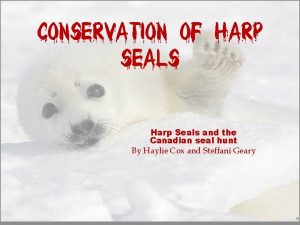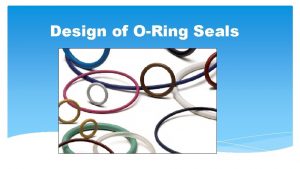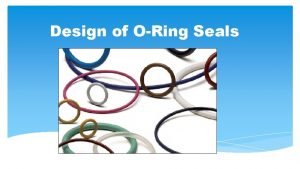HARP SEALS CANADAS HARP SEAL HUNT This and













- Slides: 13

HARP SEALS & CANADA'S HARP SEAL 'HUNT' This and the Cape fur seal massacre are the largest massacres of marine mammals in the world

HARP SEALS are PINNIPEDS "Fin-footed" mammals There are 3 families of Pinnipeds True Seals (Phocidae) including harp seals, hooded seals, and harbor seals Eared Seals (Otariidae) including sea lions & Cape fur seals Walruses (Odobenidae)

HARP SEAL LIFE CYCLE Yellow jacket Whitecoat (to ~2 wks) (2 -3 wks) (newborn) Bedlamer (13 mo. – Beater (3 wks 13 mo. ) Ragged jacket Adult (with pup) adult) Males reach sexual maturity at 7 -8 years, females at 4 -6. Females give birth to one pup each year starting at about 5 years of age.

Canada's Seal 'Hunt' About 95% of the harp seals that are killed in Canada's seal hunt are between 3 weeks and 3 months of age. How many seals are killed? Canada’s seal ‘hunt’ takes the lives of 3 species of seals. Most are harp seals, but up to 400 hooded seals are also killed and typically, a few hundred to over a thousand grey seals are killed each year. The number of harp seals killed over the years are shown below. The numbers exclude “struck & lost. ” 1950's Average to : 1971 288, 000 1996 To 1999 Average: 2006 258, 573 2007 2008 354, 344 224, 745 217, 857 1972 to 1982 Average : 160, 000 2001 2002 92, 055 226, 493 312, 367 2009 2010 2011 74, 581 67, 327 37, 609 1983 to 1995 Average : 52, 000 2003 2004 2005 289, 512 365, 971 329, 829 2012 2013 2014 69, 175 90, 318 54, 806 2015 2016 2017 35, 304 66, 800 80, 924

Where are Harp Seals Killed? The harp seal 'Hunt' takes place in two phases: Phase 1: "The Gulf" (The Gulf of St. Lawrence) Phase 2: "The Front" (Off Newfoundland Labrador)

Why are Harp Seals Killed? • For their fur - Illegal in the U. S. and now the EU, their fur is sold primarily in Asia and some countries in Europe. • Some seal blubber is sold as a 'health food supplement' since it has omega-3 fatty acids (this is also illegal in the U. S. and now the EU). • Their flesh is left to rot (since there is no market for it). • At one time, the Canadian government claimed the seals were responsible for the collapse of the North Atlantic cod population. • Proved false, the government then claimed the seals were responsible for the failure of the cod to rebound after the fishing moratorium. • Again proved false, the Canadian government now calls this a 'market -based hunt' and spends Canadian tax dollars to promote the market for seal pelts. • Nevertheless, many Canadian fishermen still believe the old claims.

More Reasons Why Harp Seals Are Killed: • Politics - the Fisheries Minister traditionally hails from the main sealing province, Newfoundland Labrador. • Tradition - sealers take 'pride' in and stubbornly cling to this bloody heritage • Political Deception – the Trudeau government is working with some in the Inuit community to conflate Inuit sealing, most of which involves killing adult ringed seals for food and personal use of skins, with the commercial seal ‘hunt. ’

How are Harp Seals Killed? The Gulf: Sealers, mostly from the Magdalen Islands of Quebec, set out in boats to the ice floes where the seal pups are born. At this time, most seal pups do not know how to swim. In the past, Canadian Coast Guard icebreaker ships created a path through the ice for the sealing ships when the ice packs were dense. Sealers run onto the ice, clubbing every seal pup in sight with a hakapik, a long stick with a hook on the end, for hooking the seal pup in the mouth and dragging it to the skinning area. A 2001 veterinary study found that over 40% were skinned while alive and conscious. Though killing techniques have changed, sealers still move rapidly, spending little time to ensure the seal pup is dead before being hooked and dragged and skinned.

How are Harp Seals Killed? The Front: Sealers, mostly from Newfoundland Labrador, set out in boats to find the seal herds. At this point, the seals know how to swim. Sealers shoot at the seal pups, aiming for their heads from their boats. The pelt is devalued with gunshots in it, so the sealers avoid repeat shots. Sealers use hakapik hooks to retrieve killed or wounded seals. Still, many escape, bleeding to death or drowning later. Estimates are that at least 5% are 'struck and lost'.

Are There Conservation Issues? The Canadian government uses estimates of the size of the harp seal population to set quotas but surveys the population only about every 10 years. The current estimate is about 5 to 8 million seals. Until 1971, the Canadian government allowed unrestricted killing. With the population on the verge of collapse, the government instituted a quota system. In 1983, kill rates decreased due to a ban on imports of whitecoat pelts into the EU. Then, as the Canadian government realized that there was a loophole in the ban - sealers could wait a week or two and kill ragged jacket or beater seal pups - the killing increased. Harp seals give birth to pups on ice floes. Seal pups do not know how to swim for the first few weeks of their lives. Without thick, sturdy ice, seal pups drown. In many years, tens or hundreds of thousands of seal pups have perished this way. With global climate change making spring ice less certain, the seals' future is in jeopardy.

What Can You Do to End the ‘Hunt’? Boycott Canadian Seafood n n n Seal products are illegal in the U. S. Although it is important to reduce demand for seal pelts, American consumers cannot affect pelt markets. Sealers are fishermen. They make only about 5% of their income from sealing. The fishing industry of Canada stands behind the seal hunt. Canadian fishermen sell about 70% of their seafood to the U. S. market. That comes to about CAN$3 billion. Revenues from seal pelts bring in about CAN$1 million to CAN$20 million per year, split among 600 to 6, 000 sealers. Sealing boat captains typically take 50% of the pelt revenues and leave 50% for the crew to split up. The Canadian Department of Fisheries and Oceans has said that the seal 'hunt' will end when the Canadian fishing industry wants it to end.

How Can You Join the Boycott? Seafood in supermarkets has 'country of origin' labels. Look for 'Product of Canada' on the tag at the fresh fish counter or on cans and jars. Avoid this seafood. Some seafood is exempt from this labeling law. This includes pre -cooked seafood, such as snow crabs and shrimp, and seafood in prepared meals. At the seafood counter, you can ask where the seafood is from. It may be on the shipping box. You can also call or email companies that sell seafood meals. Let them know that you want them to join the boycott. In restaurants, seafood does not have to be labeled. Ask your server where the seafood is from, and let him/her know that you are participating in the Canadian seafood boycott. At one time, Red Lobster was exposed as the largestbuyer of Canadian seafood, sourcing through Quebec, where the Magdalen Island sealers come from. Tell Red Lobster to avoid Canadian seafood. Some common Canadian seafood includes: snow crabs, lobsters, cold-water shrimp, Prince Edward Island mussels, scallops, cod, sole, flounder, herring, salmon, tuna, sardines, and perch. Avoiding seafood altogether is an even better option since the oceans are over-fished and suffer from pollution and climate change.

Where Can You Learn More? HARPSEALS. ORG Thanks to our fellow Seal Warriors at HSUS/HSI, IFAW, and Sea Shepherd for photos of seals and sealing.
 Harp seals life cycle
Harp seals life cycle Temperatura en las cañadas del teide
Temperatura en las cañadas del teide Canadas landforms
Canadas landforms Canadas physical geography
Canadas physical geography Whats canadas longest river
Whats canadas longest river Unit 5 food national geographic
Unit 5 food national geographic Canadas head of state
Canadas head of state What is canada's economic system
What is canada's economic system Electromagnetismo
Electromagnetismo Canadas physical regions
Canadas physical regions Canadas climate
Canadas climate Automotive fasteners gaskets and sealants
Automotive fasteners gaskets and sealants Fasteners gaskets seals and sealants
Fasteners gaskets seals and sealants 3 types of sealants used in automotive
3 types of sealants used in automotive
